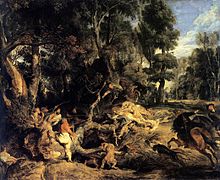Salome with the head of John the Baptist (Veneto)

|
| Salome with the head of John the Baptist |
|---|
| Bartolomeo Veneto , between 1503 and 1530 |
| Poplar wood |
| 103.5 × 62 cm |
| Old Masters Picture Gallery |
Salome with the head of John the Baptist is the name of a painting by Bartolomeo Veneto . It is located in the Old Masters Picture Gallery in Dresden .
Image description
“ The daughter of Herodias. Half figure. She stands in a green dress with red sleeves and fine pearl jewelry in front of a red curtain and holds the Baptist's head on a pewter bowl with both hands. Her golden curls fall well distributed and finely curled down on her shoulders. "
This entry in Karl Woermann's gallery catalog from 1887 describes it as a painting from the Leonardo da Vinci school , an assignment that was later changed.
It depicts Salome , the daughter of Herodias , who is holding a bowl with the head of John the Baptist in her hands . This figure from a legend of the New Testament was often used in the visual arts of the time. Salome was mostly shown as a pretty young woman with an erotic charisma, triumphantly holding up the bowl with the Baptist's head like a trophy. The paintings by Carlo Dolci , Tizian and Lucas Cranach the Elder serve as an example :
The Salome depicted here, on the other hand, does not display a triumphant gesture, the posture of the head and the pale skin of Salome rather imply the type of a sinner who, in retrospect, becomes aware of the shamefulness of her deed and thus turns pale and freezes. This impression was also given by the art historian and patron Johann Gottlob von Quandt :
"... we see a picture that shakes the mind deeply. The daughter of Herodias holds the bowl with rigid, lowered arms on which the head of John the Baptist lies. Only now does she learn that the price of her lovely dance was murder, and the blood coagulates in her veins; she herself becomes a living corpse. The unconsciousness in which we see them, the horror that petrifies them, and a deep compassion which seizes us at the sight of the innocent, who has no part in the immense deed, outweigh the horror, soften the impressions of such a scene and preserve it thereby the harmony of beauty, which the work of art must never lack; yes, the peace in the features of the noble dead has a calming effect and dissolves the dissonance.
The picture is highly tragic, because it inspires horror and compassion, as Aristotle demands from poems of this kind ... "
Naming, attribution and provenance
The picture was acquired from the Imperial Gallery in Prague in 1749 along with 68 other paintings . 50,000 thalers were paid for the whole lot , which also included the pictures “A Wild Boar Hunt” by Rubens (Gal. No. 962) and Tintoretto's “Adulteress” (Gal. No. 270 A).
In addition to the attribution, the name of the painting and thus of the portrayed have also been changed. So the painting is referred to as Herodias with the head of John the Baptist by Leonardo da Vinci or the school of Leonardo da Vinci.
In his work from 1856 Quandt refers to the painting as The Daughter of Herodias by the Leonardo pupil Marco d'Oggiono .
In the gallery catalog of 1887, Karl Woermann again refers to the painting, as already mentioned, as: The daughter of Herodias from the school of Leonardo da Vinci.
The today valid attribution of the painting as the work of the painter Bartolomeo Veneto was made in 1891 by the Italian art historian Giovanni Morelli , who found the knowledge published under the pseudonym Ivan Lermolieff on the basis of comparisons with other works by Bartolomeo Veneto. The paintings ideal portrait of a courtesan as Flora from the Städel in Frankfurt am Main and the so-called Donna Ebrea from the collection of the Duke von Melzi were decisive due to the curly hair of the women's heads.
Web links
Individual evidence
- ↑ Sabine Poeschel: Handbuch der Ikonographie. Scientific Book Society, Darmstadt 2009, p. 133.
- ^ Hans Posse : Masterpieces of the State Picture Gallery in Dresden. Franz Hanfstaengl, Munich 1924, p. 10.
- ^ Johann Anton Riedel : Directory of the paintings in the Churfürstl. Gallery in Dresden. Engelhart Benjamin Schwickert, Leipzig 1771, p. 158.
- ↑ z. B. Gallery catalog from 1843, p. 127.
- ^ Johann Gottlob von Quandt : The companion through the painting halls of the Royal Museum in Dresden. Verlag der Königl. Court book printer of CC Meinhold & Sons, Dresden 1856, p. 69.
- ^ Karl Woermann : Catalog of the Royal Picture Gallery to Dresden , General Directorate of the Royal Collections for Art and Science, Dresden 1887, p. 127.
- ↑ Ivan Lermolieff: Art critical studies on Italian painting. The galleries in Munich and Dresden. FA Brockhaus, Leipzig 1891, p. 224.






